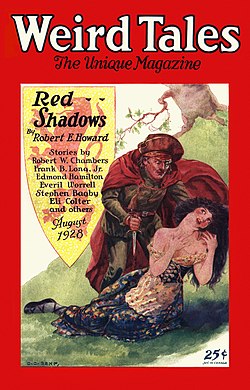
"The Vengeance of Nitocris" is a short story by Tennessee Williams, written when Williams was 16 years old. It was published in Weird Tales in its August, 1928 issue, under the byline "Thomas Lanier Williams", the writer's actual given name.[1] The story is a "surprisingly lurid"[2]: 24 tale of loosely historical fiction, based on the account of the semi-legendary female pharaoh Nitocris found in Herodotus.[3]: 596 [4] Williams was paid $35[2]: 30 (equivalent to $641 in 2024)[5] for the story by Weird Tales; it was his first piece of stand-alone published fiction.[2] Robert E. Howard's "Red Shadows", the story that introduced Solomon Kane, was the cover story.[6]
Plot
[edit]Nitocris is the sister of an unnamed pharaoh. When a bridge the pharaoh built across the Nile collapses, the pharaoh extinguishes the sacred fires of Osiris, defiles a temple with hyena sacrifices, and as a result dies at the hands of an angry mob of priests and citizens. Nitocris, now the empress, takes revenge for the execution of her brother for sacrilege by inviting his judges to a banquet in a magnificent temple she has constructed, feigning only a desire to atone for his offenses. In fact, the new temple is an elaborate death trap. Once they have gathered, she opens a sluice gate and allows the water of the Nile to drown them all, and takes a great deal of pleasure in their demise. Then, realizing that she cannot escape retribution, she has her "boudoir" filled with hot ashes and commits suicide by asphyxiation.[1]: 288 [7][3]: 596
Themes
[edit]Williams remarked about the story in a New York Times interview, that " I was sixteen when I wrote ["The Vengeance of Nitocris"], but already a confirmed writer, having entered upon this vocation at the age of fourteen, and, if you're well acquainted with my writings since then, I don't have to tell you that it set the keynote for most of the work that has followed."[3]: 597 Despite the story's somewhat florid prose ("Hushed were the streets of many peopled Thebes. Those few who passed through them moved with the shadowy fleetness of bats near dawn, and bent their faces from the sky as if fearful of seeing what in their fancies might be hovering there..."),[1]: 253 [2]: 24 [8] the story prefigures themes found in Williams's later plays. The tale features a strong female protagonist, possibly affected by madness;[8] and a brother-sister relationship is central to its plot.[7] A psychic bond of reciprocity between brother and sister, in that Nitocris expresses the belief that "even he[9] must have considered his avenging adequate", is a theme that appears in several of Williams's later works, including The Two Character Play, Out Cry, and to some extent even The Glass Menagerie.[3]: 601
The story also reflects Williams's longstanding interest in Shakespeare; Williams noted that when he was ten years old, he had been "interested in blood and guts Shakespeare", and that his favorite Shakespeare play was Titus Andronicus, the revenge tragedy.[3]: 604 Williams's Nitocris has been called the first of a long series of Cleopatra figures appearing in his works, the result of his early reading of Shakespeare's Antony and Cleopatra; these figures go on to include Blanche DuBois.[10]
References
[edit]- ^ a b c Williams, Thomas Lanier (August 1928). "The Vengeance of Nitocris". Weird Tales. Vol. 12, no. 2. Retrieved July 23, 2025 – via Internet Archive.
- ^ a b c d Spoto, Donald (1985). The Kindness Of Strangers: The Life of Tennessee Williams (1st ed.). Boston: Little, Brown & Company. ISBN 0-316-80781-8. OCLC 11523671. Retrieved July 23, 2025 – via Internet Archive.
- ^ a b c d e Hitchcock, Francesca M. (Fall 1995). "Tennessee Williams's "Vengeance of Nitocris": The Keynote to Future Works". The Mississippi Quarterly. 48 (4) – via JSTOR.
- ^ Herodotus, History: Book 2
- ^ 1634–1699: McCusker, J. J. (1997). How Much Is That in Real Money? A Historical Price Index for Use as a Deflator of Money Values in the Economy of the United States: Addenda et Corrigenda (PDF). American Antiquarian Society. 1700–1799: McCusker, J. J. (1992). How Much Is That in Real Money? A Historical Price Index for Use as a Deflator of Money Values in the Economy of the United States (PDF). American Antiquarian Society. 1800–present: Federal Reserve Bank of Minneapolis. "Consumer Price Index (estimate) 1800–". Retrieved February 29, 2024.
- ^ Replica issue from the Vintage Library. Accessed Feb. 13, 2009.
- ^ a b Hale, Allean (1997). "Early Williams: The Making of a Playwright". In Roudané, Matthew Charles (ed.). The Cambridge Companion to Tennessee Williams. Cambridge University Press. p. 13. doi:10.1017/CCOL0521495334. ISBN 0-521-49883-X. Retrieved July 23, 2025 – via Internet Archive.
- ^ a b O'Connor, Jacqueline (1997). Dramatizing Dementia: Madness in the Plays of Tennessee Williams. Bowling Green State University Popular Press. p. 2. ISBN 978-0-87972-742-0. OCLC 36930721. Retrieved July 23, 2025 – via Google Books.
- ^ i.e., her pharaoh brother
- ^ Kolin, Philip C. (Winter 1993). "Cleopatra of the Nile and Blanche DuBois of the French Quarter: 'Antony and Cleopatra' and 'A Streetcar Named Desire'". Shakespeare Bulletin. 11 (1) – via JSTOR.
External links
[edit] The full text of "The Vengeance of Nictoris" at Wikisource
The full text of "The Vengeance of Nictoris" at Wikisource